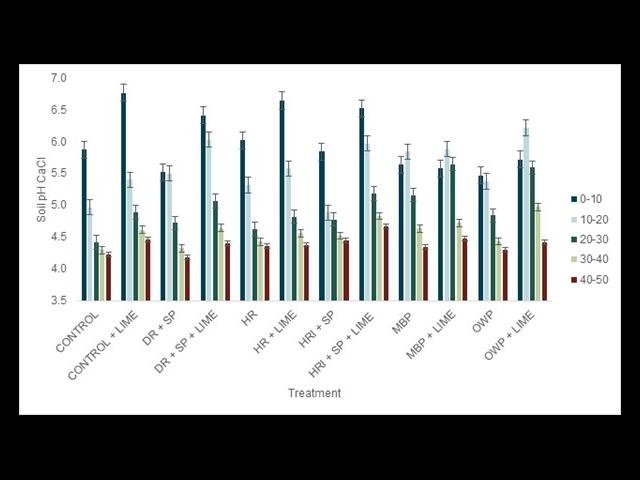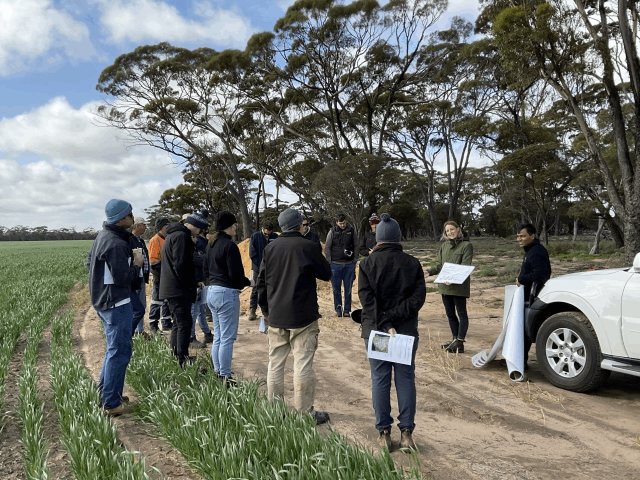Research collaboration investigates status of soil acidity in the Avon River Basin
Project name
On-farm soil acidity and nutrient management
Funded by
Department of Water and Environmental Regulation
Impacts of soil acidity
Researchers from the Department of Primary Industries and Regional Development (DPIRD) with support from the Department of Water and Environmental Regulation (DWER) and Precision SoilTech, have finished a 3-year project investigating the state of soil acidity in the Avon River Basin.
In the wheatbelt, soil acidity is estimated to result in production losses of $498 million.
Soil acidity impacts nutrient use efficiency and agricultural productivity through two main avenues:
In the topsoil (0–10 cm) low soil pH reduces the availability of key nutrients and trace elements.
While in the subsurface soil (below 10 cm) low soil pH increases aluminium in solution, which is toxic to crop roots.
The toxic levels of aluminium reduce crop root growth, affecting the plant’s ability to access to moisture and nutrients.
To counter soil acidity, farmers often use agricultural lime to increase soil pH.
However, in WA it is estimated that only 60 per cent of the required lime to treat and prevent soil acidity is currently being applied.
This study builds upon previous research by DPIRD and Precision SoilTech, looking at a vast soil dataset for the WA grain-growing region.
Between 2005 and 2012, a substantial portion of the soil had suboptimal pH levels, leading to reduced productivity and economic losses.
Methodology and key findings
Between 2020-2023, DPIRD again contracted Precision SoilTech to collect and test soil samples for soil pH. Soil test results were provided back to the growers with recommendations as well as analysed by DPIRD.
Over half of the samples had pH levels above the target range in the topsoil, and a substantial proportion exceeded critical and target thresholds by over 20 per cent (See Table X), indicating improvement since 2005-2012.
Table X. Percent of soil samples above target soil pH levels in the 2005-2012 state-wide survey region compared to the 2020-2023 Avon River Basin survey region.
|
| 2005-2012 State-wide | 2020-2023 Avon River Basin |
| 0-10cm pH >5.5 | 30% | 57% |
| 10-20cm pH >4.8 | 50% | 72% |
| 20-30cm pH >4.8 | 50% | 78% |
These results highlight growers' efforts to combat acidity in the Avon River Basin.
While the overall findings show improvement, specific examples reveal challenges in addressing soil acidity at greater depths.
The project also resampled a strategic tillage by lime field trial implemented by AgVivo in 2017 at Goomalling.
This trial compared various tillage options on a deep yellow sand, impacted by compaction, water repellence, and subsurface acidity constraints.
In 2023, six years after implementation, researchers examined how different strategic tillage options, including the addition of lime, affected soil pH levels down the profile.
The results (Figure 2) indicated that a combination of ripping and spading with lime had the most profound impact, particularly at greater depths.

Other treatments, such as very deep ripping with inclusion plates, were effective at improving pH at deeper levels.
The trial confirmed that lime helps alleviate soil acidity, but it takes time to penetrate deeper layers.
Rapid soil pH changes at depth are achievable when lime is incorporated into the soil.
To manage soil acidity effectively, addressing depth-specific acidification is crucial.
In locations where soil acidity is present down to 50 cm a deeper ripping with inclusion plates and spading could produce the greatest subsurface soil pH change benefit.
While duplex soils with clay and higher pH at the 30-40 cm depth may only require inversion ploughing.
This trial highlights the importance of selecting the appropriate tillage option and lime rate to ameliorate acidity throughout the profile.
The results from both the trial and the main project illustrate growers' efforts to combat soil acidity.
While aggregate results indicate overall improvement compared to previous studies, specific examples highlight the challenges in addressing soil acidity at depth.
The insights gained from this project highlight the importance of soil sampling to depth to determine the necessary lime quantity and incorporation strategy to effectively ameliorate soil acidity.
Contact
Alice Butler
DPIRD Research Scientist
E: Alice.Butler@dpird.wa.gov.au
M: 0488 347 929

